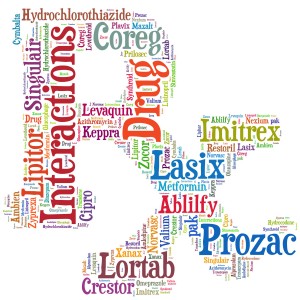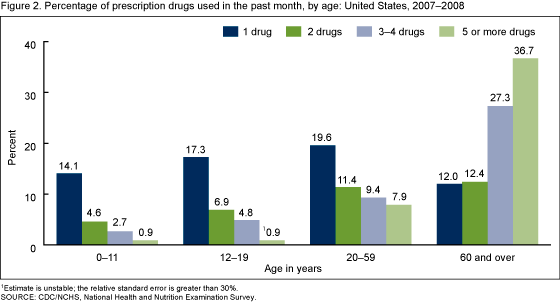Have you ever thought about the number of prescriptions your pharmacy fills every day?
The smaller, independent pharmacies are on the lower end of the scale, but it’s not uncommon for your corner CVS or Walgreens to fill 700-1500 prescriptions every day.
The use of prescription drugs in the United States on the rise and the statistics are staggering. Check out what the Centers for Disease Control reported in 2010:

Over the last 10 years, the percentage of Americans who took at least one prescription drug in the past month increased from 44% to 48%.
The use of two or more drugs increased from 25% to 31%.
The use of five or more drugs increased from 6% to 11%.
In 2007-2008, 1 out of every 5 children and 9 out of 10 older Americans reported using at least one prescription drug in the past month.
In the United States, spending for prescription drugs was $234.1 billion in 2008, which was more than double what was spent in 1999.
One of the most alarming statistics reported is the rise in the number of prescription drugs used by the elderly population. Working in home health care now, I’ve seen this first hand. Most of the clients I manage medications for take between 10 and 25 prescription drugs. The following graph from the CDC depicts this increase based on age:
What percentage of Americans used multiple prescription drugs in the past month and how did this vary by age?
The use of multiple prescription drugs in the past month varied by age (Figure 2).
- Patients often use different pharmacies due to price or prescription availability, therefore prohibiting pharmacists from having all of the medications on file being taken.
- Pharmacies are often so busy, patients just want to get their prescriptions and get home, not taking the time to talk to the pharmacist about their medications.
- Patients use different physicians depending on their specialties, and the physicians aren’t always aware of all other medications prescribed.
Due to this increased prescription volume per patient and the pressures of busy pharmacies and doctors offices, it has become necessary for patients to take some responsibility for their
own health, and learning how to discover possible drug interactions can be a life-saving tool.
Drugs.com is a reputable website to learn about your prescriptions. Tools available are:
- Pill Identification
- Drug Interactions
- Drug Use Information
- Side Effects
- Dosage Information
Over the next few weeks I’m going to provide tutorials to help you learn how to discover what your pharmacist or doctor may not have time to tell you. Some of the information is easy to understand, and some you will need to ask your doctor or pharmacist about.
You know your body—how you feel—better than anyone. And God tells us to take care of that body because it’s his temple.

You don’t have to be a medical professional to know when something is not right. The tutorials I will provide here about Drugs.com hopefully will educate you about your prescriptions enough to answer some questions on your own, but also to ask your pharmacist or doctor specific questions you want a
nswered. Don’t hesitate to ask. You are paying them, and they are there to answer your questions.
Join me on Mondays for the next few weeks to educate yourself about prescription dr
ugs and don’t get caught in the pitfalls!
And PLEASE feel free to ask questions along the way. I’m a pharmacist. It’s what I’m here for!


Will look forward to your upcoming tutorials. Thanks!
Thanks Vonda…this will be a first. We’ll see how they go!
Gosh, Celeste, so much to know! We have several pharmacists in our family, and I try to remember to pull the PDR sheet on new drugs. (I don’t always remember, and mindlessly pop whatever)
Thanks for sharing your wisdom here!
There really is Susan. Watch the tutorial next week. It will really open your eyes. I’m doing the tutorial as a Screencast (provided that I can figure it out), so it will be something a little different. Thanks for your comment!
I wasn’t aware that Drugs.com offered so much help. I usually call my local CVS if I have any questions about drug interactions. I’ve also searched on the web before but I’m pretty sure that’s not the safest route. This was very helpful, Celeste. I look forward to next week’s tutorial. Blessings!
The thing about calling is you never know if they have all of your information in front of them, plus, even pharmacists can’t possibly remember everything and all interactions despite our training. People really need to learn to check for side effects, interactions, etc…and THEN if there’s a question, take it to a pharmacist. Pharmacists can easily answer specific questions. In retail, we just deal with too many customers every day to be able to answer general questions without knowing all the information. The tutorial will be a screencast…my first attempt at that should be interesting!